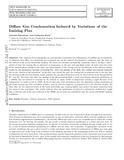| dc.rights.license | http://creativecommons.org/licenses/by-nc-sa/3.0/ve/ | |
| dc.contributor.author | Parravano, Antonio | es_VE |
| dc.contributor.author | Pech, Catherine | es_VE |
| dc.date | 2005-01-06 | es_VE |
| dc.date.accessioned | 2005-01-06T09:00:00Z | |
| dc.date.available | 2005-01-06T09:00:00Z | |
| dc.date.created | 1997-07-31 | es_VE |
| dc.date.issued | 2005-01-06T09:00:00Z | es_VE |
| dc.identifier.other | T016300000103/0 | es_VE |
| dc.identifier.uri | http://www.saber.ula.ve/handle/123456789/16979 | |
| dc.description.abstract | Diffuse gas condensation induced by variations of the ionizing flux
(Parravano, Antonio; Pech, Catherine)
Abstract
The variation of an ionizing flux as a mechanism to stimulate the condensation of a diffuse gas is considered. To illustrate this effect, two situations are examined: one on the context of pregalactic conditions, and the other on the context of the actual interstellar medium. We focus our attention on flash-like variations; that is, during a "short" period of time the ionizing flux is enhanced in comparison to the pre- and post-flash values. In both cases the cause of the induced phase change is the same: the enhancement of the cooling rate by the increase in the electron density caused by the momentary increase of ionizing flux. After the passing of the flash, the cooling rate remains enhanced due to the "inertia of the ionization". In the first case (metal free gas) the cooling rate is enhanced due to the fact that the increase of the electron density makes possible the gas phase formation of H2 by the creation of the intermediaries H- and H+2. We show that after the passing of the photo-ionizing flash a cloud near thermo-chemical equilibrium at ~ 8000 K may be induced to increase its H2 content by many orders of magnitude, causing a rapid decrease of its temperature to values as low as 100 K. In the second case (solar abundances gas) the dominant cooling mechanism of the warm neutral gas (the excitation of heavy ions by electron impacts) is proportional to the electron density. We show that, for the expected states of the warm interstellar gas, ionizing flashes may induce the phase transition from the warm to the cool phase. The results indicate that the mechanism of induced condensation studied here might play a relevant role in the gas evolution of the diffuse gas in both, the pregalactic and the actual interstellar medium conditions. | es_VE |
| dc.language.iso | es | es_VE |
| dc.publisher | SABER ULA | es_VE |
| dc.rights | info:eu-repo/semantics/openAccess | |
| dc.subject | Distribuciones autogravitantes | es_VE |
| dc.subject | Astrofísica teórica | es_VE |
| dc.subject | Astrofísica | es_VE |
| dc.subject | Plasmas | es_VE |
| dc.subject | Formación de galaxias | es_VE |
| dc.title | Diffuse gas condensation induced by variations of the ionizing flux | es_VE |
| dc.type | info:eu-repo/semantics/article | |
| dc.description.email | parrravan@ula.ve | es_VE |
| dc.description.tiponivel | Nivel monográfico | es_VE |
| dc.subject.centroinvestigacion | Centro de Física Fundamental (CFF) | es_VE |
| dc.subject.facultad | Facultad de Ciencias. | es_VE |
| dc.subject.idioma | Inglés | es_VE |
| dc.subject.keywords | Plasmas | es_VE |
| dc.subject.keywords | Galaxy formation | es_VE |
| dc.subject.keywords | Physics | es_VE |
| dc.subject.keywords | Astrophysics | es_VE |
| dc.subject.tipo | Artículos | es_VE |


